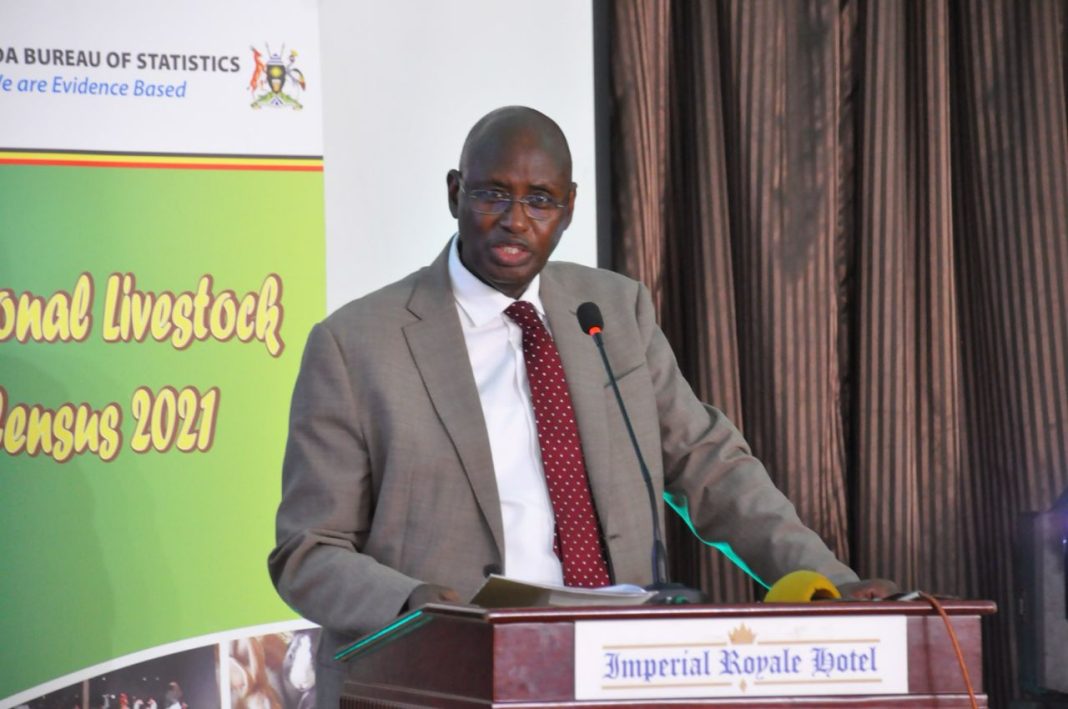Ministry leadership, led by Hon. Dr. Rwamirama Bright Kanyontore, Minister of State for Animal Industry, recognizes the census as a pivotal government initiative.
With its insights shaping planning and management strategies for the livestock sub-sector, join us as we delve into the significance of this key deliverable and its impact on agricultural development and sustainability. Below is the detailed speech;
“On behalf of Ministry of Agriculture, Animal Industry and Fisheries and on my own behalf; I am greatly honored to be with you today and with great humility, I wish to extend my appreciation to Uganda Bureau of Statistics (UBOS) for organizing such important workshop. Agriculture remains one of the largest sectors of the economy, contributing close to 24% of the GDP and employing approximately about 70% of the country’s working population and also contributing over 50% of total export earnings. About 80% of our Industry is agriculture based. The Agricultural annual growth rate has steadily improved in the recent years from 2.8% in 2016 to 3.5 % in 2020/21; and this should become better with increased public and private investments in agriculture
The overall thrust of the policy and strategic direction of Government as set out in the NDP III (2020/21-2024/25) is pursued under the overall theme of sustainable industrialization for inclusive growth, employment and sustainable wealth creation. The Agro-Industrialization program that is led by the MAAIF has made tremendous achievements.
This is being implemented through the Programme Approach. Agro-Industrialization Program is one of the key investment programs under the NDP III which is led by the Ministry of Agriculture, Animal Industry & Fisheries in collaboration with other key implementing MDAs including; Ministry of Trade, Industry and Cooperatives, Ministry of Water and Environment and Ministry of Local Governments.
In addition, Government introduced the Parish Development Model (PDM) initiative to improve service delivery. Beef and Dairy are among the Priority Commodities for the Parish Development Model. The PDM is aligned to 5 strategic objectives of the NDPIII namely: Enhancement of value addition in Key Growth opportunities; Enhancement of productivity and well-being of Population; Consolidation & increase in the stock and quality of Productive Infrastructure, among others.
MAAIF is leading the implementation of pillar one of the PDM (Production, Storage, Value addition, Processing and Marketing). The Pillar aims to support the creation of employment opportunities, food security and wealth for all Ugandans specifically the households in subsistence production.
Thus, the need for sound and reliable data in Agriculture for guiding investments in the sector is crucial. Good, reliable statistics provide us with the eyes and ears to respond to the development needs of the Ugandan population. The livestock sector is ideally placed to generate economic growth through data-driven opportunities for investment.
The Importance of relevant, accurate, consistent, timely and accessible data and information as a strategic tool for management of the livestock sector needless be overemphasized. Investing in livestock data collection leads to evidence-based policy and decision-making and opportunities for sector investment.
The importance of livestock in the country‘s economic growth and poverty reduction is well acknowledged despite challenges such as increasing demand of livestock data, lack of statistical awareness and inadequate institutional and financial resources to mention a few.
To accelerate agricultural transformation from subsistence to commercial farming, we need to implement well-designed programs that address issues identified based on robust evidence. The NLC 2021 is handy in this regard.
The NLC 2021 collected information on numbers of different animal types by breed, purpose of production, production systems, milk production, farm infrastructure, machinery and equipment, source of labour used by the livestock-keeping household, extension services, among others.
The NLC 2021 data is intended to inform Government, local authorities and other stakeholders in their planning processes. The statistical data generated during the Census will be used as a basis for better informed decision making regarding the allocation of scarce resources.
In particular, MAAIF will among other things: use the data to procure appropriate amounts of vaccines for control of animal diseases in specific districts; design a strategy for improved marketing of livestock and livestock products; and design appropriate strategies to improve production and productivity in the livestock sector.
In addition; the Census data will be used as a basis for policy making in agricultural planning. Also, Forecasting-which is a vital element in agricultural planning-will be simplified by the availability of the Census results.
Veterinary Services rely on the livestock census to develop disease surveillance and control measures as livestock population is the critical denominator for public investment plans.
Develop a comprehensive livestock and poultry sector development master plan to introduce high yielding and fast-growing exotic breeds and/or improve the quality of existing local breeds;
Increase the proportion of livestock-raising households with planted pastures; and train livestock and poultry farmers in modern livestock and poultry production and management practices and skills to mitigate the negative effects of the small household landholding sizes; the dismal proportion of livestock-raising households with planted pasture;
Increase the low levels of adaptation of exotic breeds and the limited utilization of hired labor coupled with the ever-increasing human population on the growth prospects of the livestock and poultry sector.
Establish supporting infrastructure for livestock rearing like dams, valley tanks, boreholes, dip tanks, quarantine stations, milk cooling plants as well as well-equipped livestock markets.
The supporting livestock infrastructure should be spread across the country in proportion to the total number of livestock in a particular region or district using the livestock data generated in this census. Livestock movement routes and holding grounds should also be established based on effective demand.
With these remarks, I take the opportunity to invite my Hon. Senior Minister to launch the report and close the dissemination workshop.
Thank you.
For God and My Country
Lt Col (Rtd). Dr. Rwamirama Bright Kanyontore Ph.D
Minister of State for Agriculture, Animal Industry and Fisheries/AI
“























